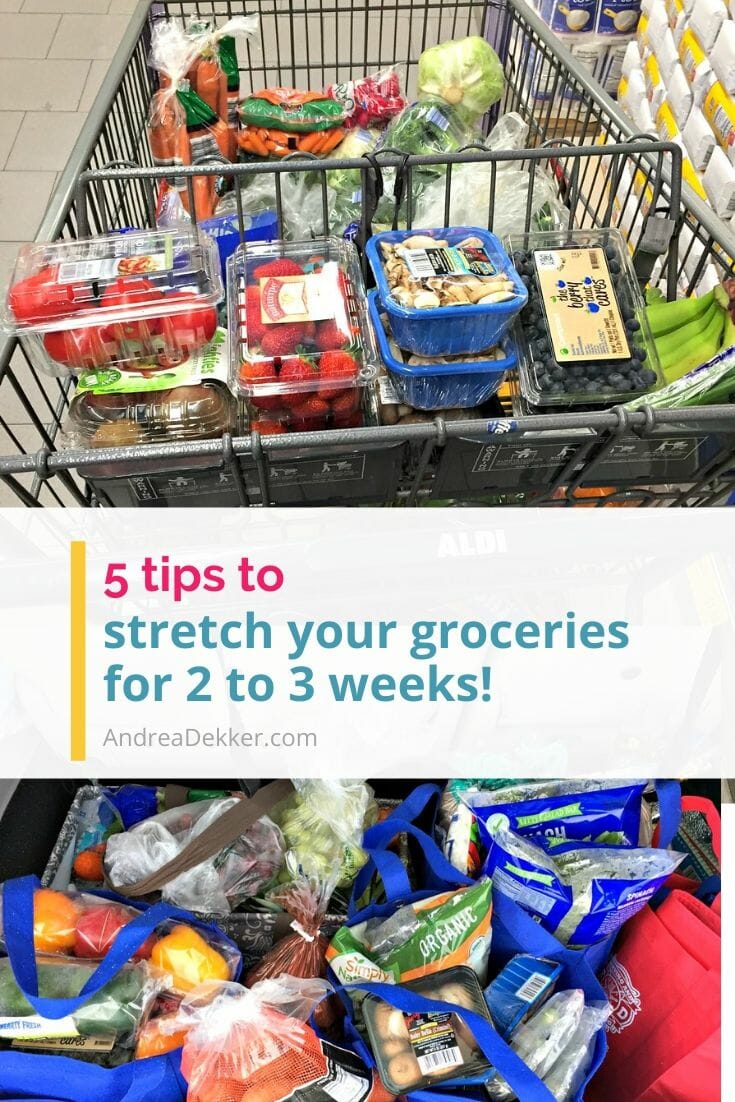
Over the past few years, our family has made an effort to include significantly more fresh produce into our daily meals and snacks.
This new way of eating presented a “problem” for me because I dislike grocery shopping… but in order to keep our fridge stocked with fresh produce, I felt like I needed to head to the store every other day.
Thankfully, after a few months of way too much grocery shopping (with 4 children in tow) I came up with a new system for buying, storing, prepping, and consuming a huge amount of fresh produce (and other perishable groceries) to reduce the number of shopping trips I made each month.
Now, I often get groceries every 2 to 3 weeks… for our family of 6!
So how do I stretch our produce and other perishable items for 2 or 3 weeks?
Keep reading!
During this time when we’re asked to stay home as much as possible, my 5 tips to stretch your groceries should help you avoid the grocery store for weeks at a time (while still enjoying a variety of fresh produce!)
1. I make weekly meal plans.
I can’t stress meal planning enough!
Even if you DON’T want to shop in bulk, meal planning is still so beneficial for your week.
However, if you DO want to reduce your grocery shopping frequency by shopping in bulk every 2 to 3 weeks, meal planning is an absolute ESSENTIAL!
I don’t go crazy planning months of meals at a time, but I do always make a general meal plan for each week (including side dishes I plan to serve). This helps to assure all the foods I need are on my grocery list (or in the freezer/pantry/fridge) and avoid lots of last-minute trips to the store throughout the week.
As the weeks go on, I try to use up leftovers, eat from the freezer, utilize pantry staples (dried pasta, beans, rice, etc.) and get a little more creative with whatever food we have in the house. I’ve honestly found some of our most favorite meals this way!
RELATED READING: Meal Planning For Beginners
2. We have an extra refrigerator.
An extra refrigerator is not 100% necessary to stretch your grocery shopping. However, I’m honestly not sure how I would make it work for our family without one.
Thankfully, we’ve had an extra refrigerator ever since we finished our kitchen renovation back in 2012!
Our fridge is getting old, and I’m sure it’s not the most efficient, but it comes in handy for hosting parties, prepping for holiday gatherings, storing extra garden surplus, and stock-piling 2 to 3 weeks worth of produce, dairy, eggs, etc. when I get back from my huge grocery haul!
RELATED READING: How I Store, Prep, and Serve all our Fresh Produce
The extra refrigerator allows plenty of space in our kitchen refrigerator for the fruits and veggies we’ll use in the next 36-48 hours — along with various leftovers, meats, cheese, snacks, beverages, condiments, and foods I have already prepared for upcoming meals.
Both refrigerators are STUFFED full after unpacking the groceries, and they are both VERY empty by the time I’m ready to head back to the store again.
3. We have an extra freezer.
We have a medium-size deep freezer in our basement, which I use daily for storing frozen veggies, frozen fruit, pre-cooked (and uncooked) meats, extra cheese, etc.
I put almost anything and everything in the freezer — making shopping in bulk SOOOO much easier.
RELATED READING: 50+ Freezable Foods that Will Save You Time and Money.
We also have “cold storage” in our basement. This is where we store potatoes, sweet potatoes, onions, squash, apples, etc. It’s especially cold in the winter months.
4. We eat the most perishable foods first.
Along with having an extra refrigerator and freezer, I make a point to prepare and serve our fresh produce in order from “most perishable” to “least perishable”.
This assures we eat a large variety of produce AND that our produce doesn’t go bad before we have a chance to eat it.
For example, we’ll start by eating berries, kiwi, grapes, bananas, cucumbers, tomatoes, beans, sliced mushrooms, spinach, arugula, etc.
Then we’ll add in pineapple, oranges, melons, pomegranates, avocados, peas, peppers, zucchini, whole mushrooms, head lettuce, etc.
As our stockpile starts to dwindle, we’ll rely more on apples, oranges, broccoli, cauliflower, beets, squash, kale, etc.
Foods like onions, potatoes, sweet potatoes, carrots, celery, squash, apples, pineapple, melons, and even fresh herbs will keep for WEEKS if properly stored and kept cold. We eat these throughout the 3 weeks with no issues at all.
And if we really run stuck, I always have my home-canned tomatoes as well as frozen corn, broccoli, and peas!
IF the fresh produce looks like it’s starting to go bad, I immediately wash it, chop it up, and put it in the freezer. This does not happen all that often, but I have several zip-top bags in the freezer for bits of peppers, celery, zucchini, berries, bananas, apples, grapes, spinach, etc.
We use these bits and pieces for quick breads, muffins, soups, quiche, and smoothies.
Produce is rarely ever wasted in our house and we end up eating a huge variety of different fruits, veggies, and greens!
RELATE READING: How to Reduce or Even Eliminate Wasted Produce
5. I do “quick pickups” in between my major shopping trips.
Although my goal is always to stay OUT of the grocery stores, I do occasionally do “quick pickups” when we run low on staples like milk, eggs, bananas, etc.
We have a small, more-expensive grocery store within walking distance of our house, and ironically, they often have really good prices on eggs and bananas, so when the weather is nice, the kids and I often walk or ride bikes to that store just for something to do.
We pick up bananas, a couple dozen eggs, and usually a fun snack. We eat the snack at the little fountain courtyard outside the store, and then ride home again!
What I buy to feed our family for roughly 2 to 3 weeks.
I’ve been asked countless times to share exactly what I buy from the grocery store on my big grocery runs.
I’m not sure I can answer this with total accuracy since my grocery cart looks slightly different every trip.
However, this is a fairly accurate picture of what I buy and what we eat every couple of weeks.
FRUITS:
- strawberries — 3-5 pounds (depending on price)
- blackberries, raspberries, and/or blueberries — 2-6 pints of each (depending on price)
- green and red grapes — several pounds of each
- bananas — 15-20 (I sometimes purchase more throughout the 2-3 week period)
- clementine oranges — two 5 pound bags
- avocados — 6-10
- kiwi — 1 box of 6
- pomegranates — 3-4 (when in season)
- pineapple — 3
- muskmelon — 3
- apples 6-10 pounds**
**We buy apples by the bushel from our local orchard from August through March.
I also use these apples to can our applesauce on a yearly basis. From March through July, I buy 6-10 pounds of store-bought apples in addition to everything listed below.
VEGGIES:
- mushrooms — 4-6 containers
- green beans — several pounds**
- snap peas — a large bag
- Roma tomatoes — 1 box of 6**
- cherry tomatoes — 2 pounds**
- green peppers — 3
- red peppers — 3
- orange peppers — 3
- yellow peppers — 3
- zucchini (green) — 6**
- zucchini (yellow) — 3**
- mini cucumbers — 3 pounds (I purchase more after a week or so)
- large cucumbers — 3
- Brussels Sprouts — 2-3 pounds
- beets (with greens) — 3 bunches (9 good-size beets)
- radishes — 2 bags
- cabbage — 3 heads
- broccoli — 4 packages
- cauliflower — 4 heads
- celery — 2 bunches
- carrots — 6 pounds
- baby carrots — 3 pounds
- green onions — a lot!
- yellow onions — 3 pounds
- red onions — 3 pounds
- sweet onions — 3 pounds
- sweet potatoes — 10 pounds
- russet potatoes — 10 – 20 pounds
- spaghetti squash — 2**
- butternut squash — 3**
- corn and peas (a couple of bags, frozen)
**In the summer/fall, we grow tons of zucchini, squash, tomatoes, cherry tomatoes, beans, herbs, etc. so that helps to cut costs on produce from June/July through October!
During the rest of the year, these are the veggies I buy almost every time I hit the grocery store.
GREENS:
- spinach — 2 large bags
- arugula — 1 bag
- romaine lettuce — 6 heads
- kale — 2 bags
- beet greens (from the beets listed above)
- cilantro — 1 large bunch
- parsley — 1 large bunch
As I mentioned above, this is still an estimation.
It all depends on what items are on sale, what items are in season, what items the store has stocked, what the produce looks like in the store, etc. etc.
However, this is a pretty accurate picture of what my Aldi shopping cart looks like every 2 to 3 weeks (the cashier often asks if I’m a vegetarian!)
My Aldi bill is usually around $125 every 2-3 weeks for ALL that fresh produce — and produce is definitely the main thing I buy at Aldi.
DAIRY + EGGS:
We buy a TON of dairy and eggs every month as well — you’d be surprised how long these items last.
Eggs, milk, and cheese easily have long refrigerator life, so there is usually no need to head back to the store for more of any of these items.
We’ve actually started buying a few dozen eggs each week from friends at church who now have more chickens and enough eggs to sell. However, I still need to supplement with store-bought eggs as we often go through 6-12 eggs a day.
I get almost all our dairy and eggs from Costco.
- eggs — 5-7 dozen (I divide them into single dozen containers at home)
- plain Greek yogurt — 3 tubs (3 pounds each)
- plain yogurt — one 4 pound tub
- cottage cheese — 2 large tubs (3 pounds each)
- Cheddar cheese — 2 blocks (2 pounds each)
- Colby jack cheese — 2 blocks (2 pounds each)
- Feta cheese — 2 large containers (I divide them into smaller containers at home)
- heavy cream — 2 pints
- butter — 4 pounds
- hummus — 1 large container
- milk — 3 gallons (we buy this from Meijer)
I spend right around $200 at Costco every month — I try to go to Costco on a different week than I go to Aldi and I’ll pick up more tomatoes, cucumbers, and bananas if we need more.
I also buy peanut butter, maple syrup, salsa, vitamins, toilet paper, and paper towels from Costco.
RELATED READING: What I Buy At Costco
MEAT:
Beef: Dave’s parents gift us a quarter of a cow every other year, This is usually enough beef to cover our needs for 2 years.
Pork, bacon, sausage, chicken, fish: I buy most of this from Aldi these days (I previously purchased from Zaycon Fresh before they went out of business). I buy in bulk and stock our freezer.
Lunchmeat: We don’t eat a ton of lunch meat, but this is one thing I still go to Meijer for — they have a great deli!
Summer sausage, pepperoni, hot dogs, and other “processed meats”: This is also factored into my Meijer and Costco budgets below — I just buy them as-needed or when they go on sale.
EVERYTHING ELSE:
To be perfectly honest, there isn’t much else I buy from the grocery store these days as I make most of my own bread and we get meat in bulk from the butcher.
If I need something special, I just add it to my list and pick it up the next time I’m at a grocery store — but this is rare.
I buy my household cleaning products, soaps, lotions, toiletries, diapers, wipes, etc. from Grove.co. They deliver to my house every month — it’s fantastic!
I also place a large order with Country Life Natural Foods every 6 months or so. This is where I buy all my wheat berries, oats, beans, rice, legumes, seeds, dried fruit, spices, honey, etc. They have excellent bulk pricing and free delivery on large orders.
Rough Cost Breakdown:
Aldi = $125 every 2-3 weeks ($2166 – $3250 per year)
Costco = $200 every month ($2400 per year)
Meijer = $20-$100 every 2-3 weeks, or as needed for items Aldi doesn’t sell…and Meijer milk! ($350-$2600 per year)
Grove = free with affiliate credit
Eggs from church friends = $10-$15 per month ($120 – $180 per year)
Apples and other produce from local growers = ($200-$300 per year)
Bulk Food = $200-$250 every 6 months ($400 – $500 per year)
If I did the various calculations correctly, this breaks down to ROUGHLY $110 – $175 per week on groceries.
Of course, I don’t actually shop “weekly”. Some weeks I literally spend nothing on groceries and other weeks I’ll spend $350 or more — it just depends on the week, what stores I go to, and how long it’s been since I shopped last!
Either way, I’m satisfied with that weekly estimate — especially considering the enormous amount of fresh produce I’m buying, and the fact that we regularly invite people over for dinner and make food to bring to others.
RELATED READING: How to Save More and Spend Less (a look at our spending over the last 4 years)
As I mentioned above, this is not an exact science by any means. If there is a great sale on some type of produce, I’ll definitely buy more and we’ll eat that instead of other fruits and veggies (or I’ll put a bunch of it in the freezer for later).
We also don’t need to buy as much produce in the summer and fall due to our garden — so our numbers are lower in the summer and higher in the winter.
The point of this post is not to hem and haw over what a grocery budget should be for a family of 6 — it’s to show that it’s possible to eat lots of fresh produce without grocery shopping every other day!
Over the last 2 to 3 years, I’ve learned that as long as I’m organized, plan ahead, and keep up with cooking and prepping foods at home, it is VERY POSSIBLE to eat fresh foods without spending huge amounts of time shopping every other day (and without wasting food).
Believe me, I would not be able to stay on top of serving my family fresh fruits and veggies at every meal if it required multiple weekly grocery trips!
You know how much I hate grocery shopping — and this is just one more way I’ve managed to stretch out our trips to the store!
Want to read more about my grocery shopping over the years?
Here are a few previous Grocery Shopping posts:
August 2019 what I buy at Costco
May 2018 my Aldi shopping experiment


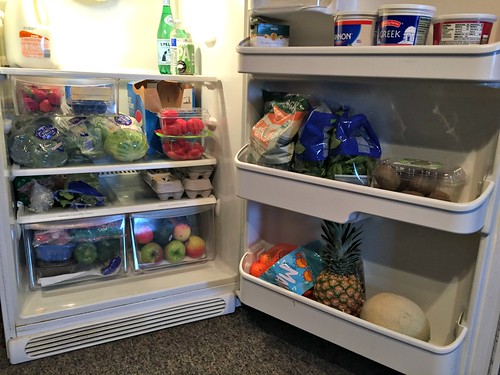
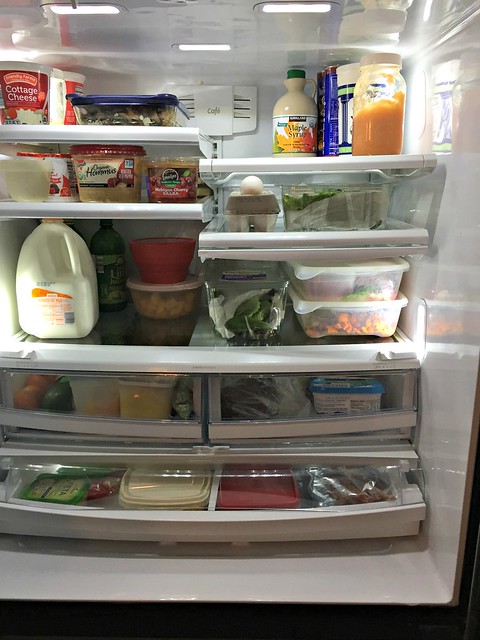
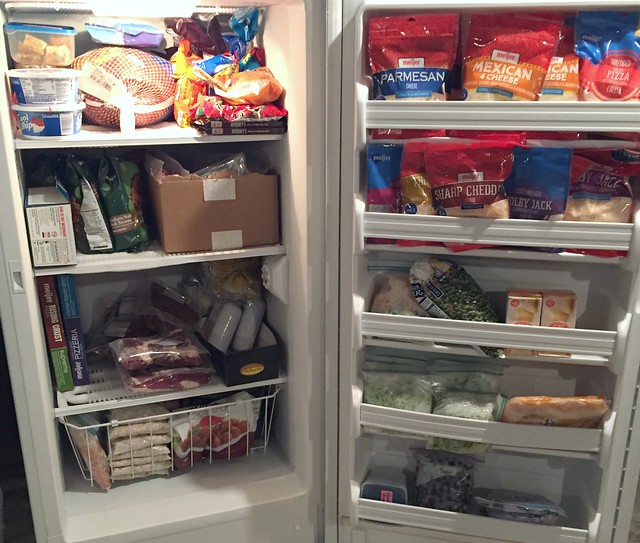
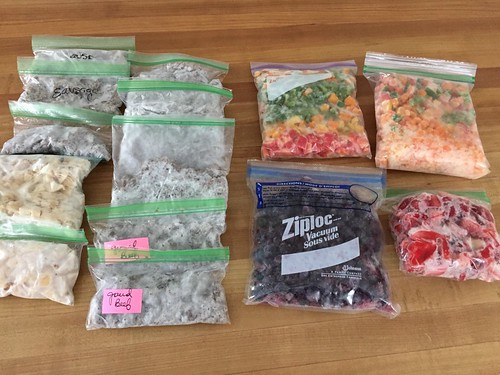
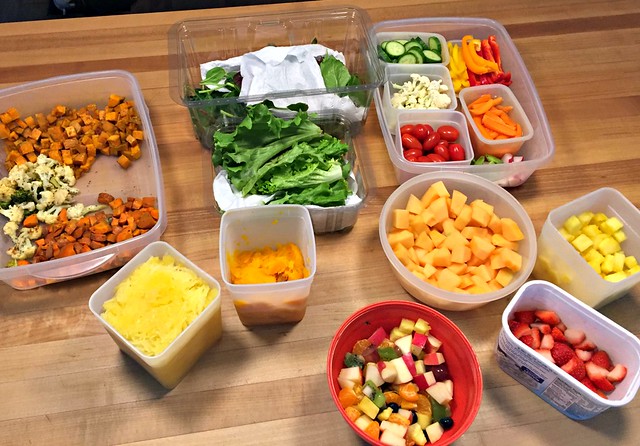

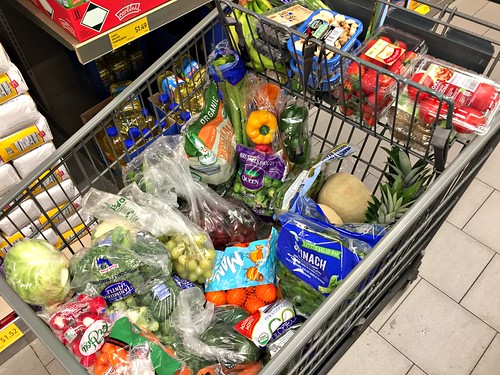
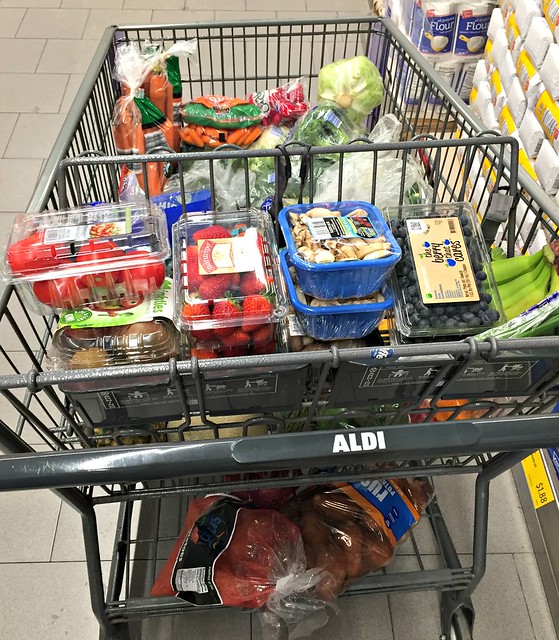
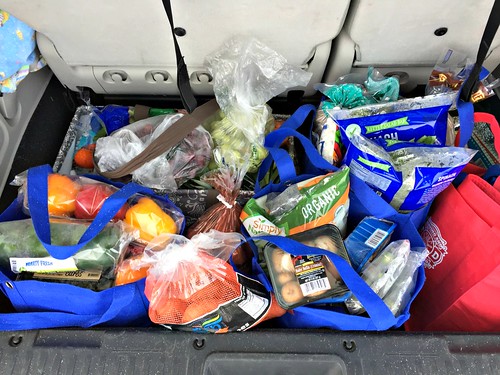
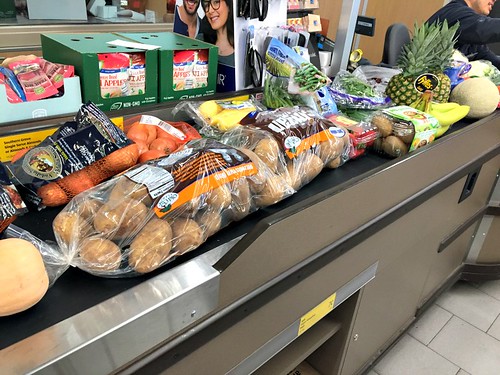
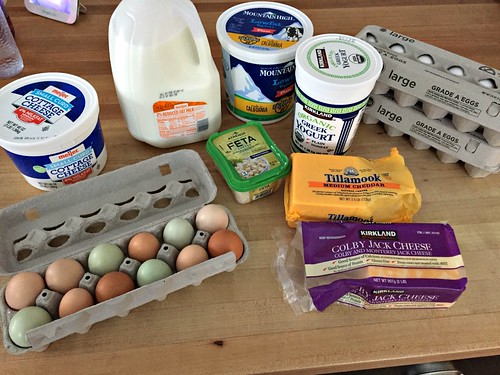
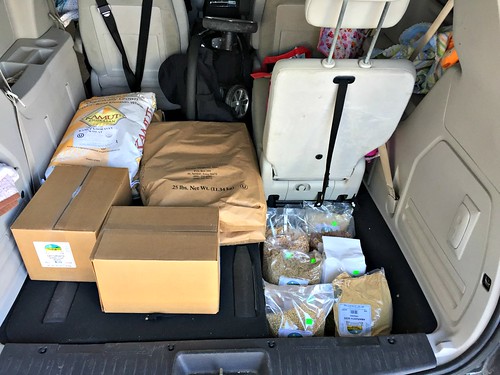

Jennifer says
Hi I was wandering if you every buy processed foods? It seems like I don’t know what to give my kids for snacks and I feel like they eat too much junk (cereal, frozen food) for snacks in between meals. Any advice?
Andrea says
Hi Jennifer,
Yes, I DEFINITELY buy processed foods (here’s a full post I wrote about that!) Also, here’s a post I wrote about snacking that might be helpful.
As far as snacks in our house, our main offerings are usually goldfish + pretzels, grapes + cheese, granola bars, trail mix, yogurt, apples + peanut butter, crackers + peanut butter, or string cheese. I always have these options in the house.
We also often have cookies, ice cream, or popsicles for dessert at least once per day.
I’m not a dietitian but I have talked with my doctor about this and she said if our kids are getting at least 2 fairly balanced meals each day with some healthy-ish snacks in between, we’re doing great 🙂 Don’t put too much pressure on yourself — as long as they’re not hungry, you’re probably doing OK!
Oh, and finally, here are a few more of my posts about snacks… clearly it’s a big topic in our house!!
Mandy says
Except for the cow part, this sounds pretty much the way I operate and this household consists of two old retired people. One thing you might want to consider is a vacuum sealing gadget like a Food Saver. I use our chest freezer a lot; our nearest Costco warehouse is 120 miles round trip so we really stock up on meat and cheese when we go. Transferring things from their packaging into vacuum sealed bags helps avoid freezer burn and shrinks down volume considerably. I’ve also started dividing those giant bags of frozen produce, so I don’t eventually find huge fruit and vegetable snowballs.
Andrea says
great tip — I haven’t ever used a vacuum seal bag before but I’ve always been interested in it. Maybe it’s something I should try and then report back on the blog!
Mary says
I love stocking up too. But in these days of the pandemic, please remind your readers that for certain items, if you stock up for 3 weeks may mean some other family doesn’t get what they might need for the next week. I live in a community with one nice grocery store and at different times I’ve seen milk, eggs, bread and most recently Campbells soup be in very short supply. While we all want to go out as little as possible, “stocking up” can easily look like hoarding. I guess when we’re all wearing face masks you can’t see others scowling at you.
Andrea says
this is a very good point Mary — thanks for bringing it up.
yes, I think there is a fine line between hoarding and simply stocking up so you don’t need to go back to the store for 2-3 weeks. And yes, I think one person’s definition of “hoarding” might be another person’s definition of “stocking up”. It’s a tricky time right now — that’s for sure!
Erin says
I’m planning to check out your other posts but any recommendations for keeping greens like lettuce and spinach last longer?
Andrea says
Hi Erin… YES!! I have the exact information you’re looking for right here!
Nancy says
I have just read about how to dehydrate zucchini. I’ll give that a try. This would be a great way to add nutrition and flavor to soups/casseroles whenever I want. We’ll see!
Andrea says
interesting! I’ve honestly never thought about dehydrating zucchini — it would probably take a really long time because of how “wet” it is!
Rhonda says
I do what you do. Meal plan is a must. We don’t have an extra fridge, but do have a full size freezer in the basement. In our area, Kwik Trip gas stations have great deals on milk, bread (made in the state), eggs, butter, cheese, bags of apples & oranges, bananas (often 29-39 cents per pound), etc. I can make a large pickup at a local grocery store or Walmart every couple weeks, and then Kwik Trip in between.
Andrea says
sounds like a great system — and yes, always meal plan!
JJ says
Excellent tips!!! How do you prevent foods from spoiling? I cannot make cauliflower or strawberries last much longer than a week before there is a ton of mold and/or mush. I also had a red pepper go rancid in my fridge. It was one of the worst smells. Do you have certain spots in your fridge that work best for certain foods? I have used your paper towel trick with the spinach(and our large bag of fresh cut broccoli)–thank you!!!
I spend about $200-$250/week for groceries and toiletries(including things like allergy medicines and other pharmaceutical needs). I simply use Walmart Grocery Pickup. I can see the subtotal as I add items to my cart. I can also click the heart button to indicate a favorite. There is a favorites tab on the app, so I can easily click that and add our regularly purchased items quickly. I am so thankful for all of the grocery store workers and all they do to provide services so that we can all purchase food.
Andrea says
I think it might depend on where you buy your groceries from (and where your grocery store gets their produce from). I usually buy 3 or 4 cauliflower at a time because it seems to last forever in our fridge. Strawberries can go at least 10 days if not longer for me (and we’re picky about our berries).
One tip for strawberries, you can rinse them in vinegar water before putting them in the fridge. This will kill off some of the bacteria that causes them to go bad faster
JJ says
Thank you, Andrea!!!
Calliope says
Cauliflower also lasts for ages in my fridge. As long as each veggy/fruit category is in each own plastic bag and inside the designated fresh produce drawer, I find that they can easily last for more than 2 weeks. Strawberries are a bit tricky and the vinegar trick seems to help for a bit longer. I freeze all the rest for smoothies, jam etc
I also cut and freeze into containers greens like persley, mint, dill because I use them all the time and I never want to be without!
As per Andrea’s advice, I’ve started cutting and slicing all the fruits/veggies that we are going to need for the next 3-4 days and that has helped a lot with consuming more fresh things and also with lunch preparation (lunch is here the main meal of the day)
Andrea can butter freeze nicely? And then be used as usually from the fridge within a few weeks?? Thanks!
Claudia Stewart says
Yes you can freeze butter!
Andrea says
hi — sorry for the delay! I forgot to respond to your question earlier. YES! you can totally freezer butter. I freeze pounds and pounds of butter. It will last for a very long time in the freezer with zero effect on taste or it’s effectiveness in baking/cooking etc. !
Ashley Orfe says
I also shop for two weeks at a time, and I’m really enjoying not frequenting the grocery store so much! There’s only two of us though so it’s easy. I’m impressed you can do this for a whole family!
Andrea says
what I’ve found is that even if we are running low on produce, dairy, etc. we’ll just “make due” with what we have. If that means having some odd meals for a couple days, then so be it. It’s sometimes hard to not let myself “quick run to the store for a couple things”, but I know if I do that, I’ll end up buying more and spending a lot more too. So while I do try to buy enough for a full 2-3 weeks at a time, I also don’t mind needing to compromise and get “creative” in the kitchen for a few days as well.
Marva says
My second refrigerator recently died and the garage food storage is my one reason to be thankful for living in Nebraska in the winter!
Andrea says
haha — yup! In the winter, we have LOTS of extra cold storage!! 🙂
Kate says
This is a great post. I feel like I need to come back to it later and comb through slowly- there is lots here! I feel like I could definitely do better as far as planning goes so I could shop less. And it’s funny, I was just telling my husband yesterday that we need a second fridge!
Andrea says
haha — yes, A LOT of information. That’s why I broke it down into 2 posts because tomorrow’s post is REALLY long too (I originally had them all smashed together as one ginormous post!)
And yes, our second fridge has been a HUGE positive when it comes to grocery shopping, meal planning, entertaining, etc.
Avia says
I live 60 miles from a major grocery store although we have a small, more expense alternative in our town. I basically do the same as you for produce. We are currently on the market for a new main fridge and I am amazed at how small some of the produce drawers are in the fridges! Most people obviously don’t stock produce like us!
Andrea says
wow — that’s a LOOOOONG trip to the store! I’d honestly be tempted to shop at the expensive store and save myself 2+ hours of driving.
And yes, we use our produce drawers, but in all honesty, 3/4th of our fridge is essentially some type of produce 🙂
I’m sharing more details and more pictures in tomorrow’s post!
Rachel says
I’d be curious how much more you would spend without the free/affiliate items. We have purchased bulk beef from a local farm before, but the quality didn’t thrill me, and I’ll probably never get enough people to buy from affiliate links to get anything that way. So, I’m curious if you had to pay for meat, diapers, household goods, etc. how much more would that be for your household? Where would you buy your meat from? Thanks! I’m also in the Midwest. 🙂
Andrea says
I’d probably just buy everything else form Aldi, Meijer or Costco — depending on where I was shopping that week. I’ve been fortunate to get so much affiliate credit for things we’d need to buy on a weekly basis anyway!
Ashley Tubbs says
Hey Andrea, I don’t know if you have an Azure Standard drop near you but you should look into them! I just compared prices on hard red wheat and soft white wheat and Azure was significantly cheaper than Country Life on both! Those are the only two products I compared, but worth looking into. The one downside is they only ship once/month and you have to meet the truck. It’s worth it for us though!
Annette Silveira says
I’ve started using the silicone ReZip bags from Target to store my produce and freezer storage. I like them a lot. They wash up well in the dishwasher or by hand. They are an investment up front but I will save on Ziplocks in the long run, not to mention throwing away all those plastic bags. I did reuse as many as possible, but throwing them away st some point is inevitable.
Leslie Polokonis says
Andrea, did you address meat and fish expenses? How does this affect your budget?
Christine says
Same question 🙂
Andrea says
no I didn’t — but I just went back and updated the post to reflect this expense. Short story, we got much of it for free as I was part of a co-op that gave referral incentives for meat purchases and Dave’s parents have gifted us with a 1/4 of a cow a few times over the past several years!
Molly Johnson says
Thank you! I was just thinking last week about how much time I spend at grocery stores, and I would like to cut that time down. But my cart is full of fresh produce and I don’t want any to go to waste. Today’s post is excellent and I’m looking forward to tomorrow’s on keeping all of that produce fresh!
Andrea says
it’s definitley a ‘learning curve’ and a different way of meal planning when I have SO much fresh produce to use appropriately before it goes bad, however I do it now without a second thought! And yes, I do save quite a bit of time by not grocery shopping multiple times a week!
Brenda says
I’ve never had great luck with Aldi’s “soft” produce (mostly fruit, I guess). It seems to spoil quickly, at least faster than that I get from other stores. I always wondered whether is was that they buy slightly older produce to get it cheaper or their stocking methods. Maybe I should try it again… Or maybe my family just doesn’t eat it fast enough. Great post. I’m looking forward to tomorrows post about how you prep it all.
Andrea says
you know — it might just be YOUR Aldi store. I absolutely REFUSED to shop at Aldi for years and years because the store closest to me had awful produce. However, exactly a year ago, a new Aldi location opened just a bit further away and it’s AMAZING! So open, clean, fresh. Their produce is fantastic (often better than Meijer) and so much less expensive!
I have had some issues with purple grapes, but everything else has been so tasty and fresh. So… it’s probably not you, just your store!
Lea says
We tried all three Aldi within driving distance of us and had the same experience you did, Brenda. The produce at all three was hit or miss for any type of longevity – typically miss. Since I refuse to go shopping more than once per week, I buy my produce at the “regular” store. Our three close Aldi stores also has really high prices (often higher than the “regular” store by a fair amount), so I don’t find it worth it to shop there as a general rule.
Andrea, thanks for this post! We buy a ton of produce and you’ve inspired me to do even better.
Lea
Melissa says
I would love to know how you use/prepare your beets. That is one vegetable that mystifies me and, frankly, makes me squeamish.
Andrea says
I just peel them, dice them, and roast them with my other veggies. It took me a few weeks to really start to enjoy them, but now I absolutely LOVE their sweet taste. They add so much flavor when mixed with other roasted veggies!
I also like them raw — shredded into salads or coleslaw — but that’s a messy job!
Margaret says
I eat beets almost every day. I make jar salads for work, and beets are usually the bottom layer. I slice and dice, and then cook them in the microwave, and let them cool before adding them to the jar.
Also good roasted with other veg.
And a delicious soup–a vegetarian variation on Russian borscht. Saute finely chopped onion, garlic, and green pepper, and chile flakes. Add cubed beets and potatoes (you can add chopped cabbage, too, but it gets slimy if you freeze it). Add dill, bay leaf, pepper, and salt, and enough water to make soup. Cook until the vegetables are soft. Add about 1/2 c vinegar after you take it off the heat–it’ll be sad and bland if you don’t. Puree if you like, and serve with sour cream.
It’s a beautiful pink.
Andrea says
yes, yes, and yes! All of these ways sound yummy!
I have beets almost every morning for breakfast (I know how ridiculous that sounds but I love them). They are so sweet and juicy, they pair excellent with other roasted veggies, fried eggs, toast, bacon, etc.
Calliope says
Hi Melissa! We eat a ton of beets in my family. I wash them thoroughly and then either boil them or bake them in the oven until soft. Then I peel them and slice them.
Most times I add olive oil, salt, garlic and vinegar and eat as a salad side dish.
Other times I cube them and add garlic, vinegar, salt and pepper, roughly ground walnuts and mayo and greek yogurt in almost equal quantities. This makes an amazing cold salad that can hold in the fridge for a few days.
Andrea says
Yum — your beet recipe sounds delicious (but I love roasted beets!)
Barbara Kelly says
I wrap whole beets in foil, and then roast them in the oven. They freeze well like this. Once thawed (still in the foil), they are easy to unwrap and remove the skin , beet top and tail = ready for eating.
The roasting in foil method saves SO much staining of cooking pans and pots from beet juice, and also keeps the juices in the beets – no “dried out” beets!
One of our favorite beet salads uses beets with homemade Honey Mustard and Dill Dressing. We add chopped apple and celery to the beets; and also some chopped toasted walnuts.
Alison says
Thanks for sharing this. I have an Aldi cart like that about once every week and a half. I have a FULL Costco cart every two weeks. The ages and appetites really matter. We are BIG eaters (except my 4 year old). 2 adults, 14 year old boy (pre-puberty), 11 year old boy (competitive swimmer), 5 year old girl, 4 year old girl, 3 year old girl. We eat tons of fresh produce too. I often wonder how I could afford it without Aldi…and we almost never eat out because we have a ton of dietary restrictions…
Andrea says
yes, that’s a lot of kiddos and I hear teenage boys eat A LOT! We also almost never go out to eat, so every meal is eaten at home (which means more groceries!)